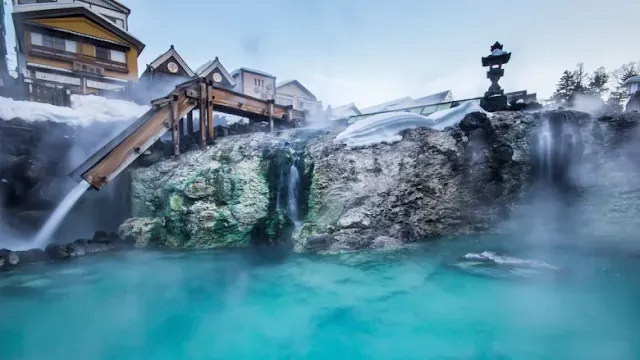Geishas are rare and uncommonly beautiful creatures who labour on their appearances before performing or appearing in public. They dress in vivid butterfly kimonos, style their hair in elaborate fashions and dust their red-stained lips with crystallised sugar. Nobel Prize-winning author Yasunari Kawabata described their white painted skin as having the “lustre of a seashell” in the moonlight.
 |
| The two geisha leave a laneway in Kyoto |
For decades, geisha – which means “person of the arts” - were misunderstood by Westerners and thought to be sex workers, not entertainers who sing and dance at traditional teahouses.
The largest surviving community of these exquisitely costumed artists – only about a thousand still remain in Japan - lives in Kyoto, though they are usually hidden from public view. But last week, I was strolling with my son through the back streets of the city when I saw two of them talking in a laneway. We stood still, struck, then quickly took a photograph and watched them part; one trotted on her wooden shoes back down the lane, while the other merged into the crowds of Gion with a fixed expression on her face.
And then the ugliness began. A throng of people surrounded her, some tourists in rented kimonos, taking photographs, trying to take selfies, manoeuvring professional cameras with long lenses as she ducked her head and kept walking.
A zoo without enclosures.
This is not novel behaviour and there are reports that it has been growing worse. There are now signs on the streets of Kyoto warning tourists not to eat while walking, not to litter, sit on or lean against bamboo fences - and not to place hands on geishas. There are stories of geishas breaking down in tears, being hurriedly placed into taxis for protection, being afraid to venture out. They have complained of having their kimonos constantly tugged and now locals have banded into patrols to protect them from harassment by foreigners.
My friend Damien, a photographer whose exhibition Wabi Sabi, of photos of emptying rural towns, shops and schools was an exquisite exploration of the effect of urbanisation in Japan, says he has witnessed and heard stories of tourists becoming increasingly disrespectful.
 |
| The Kusatu Onsen in Gunma Prefecture |
“Many people have zero cultural sensitivity. I’ve seen people do bombs into rotenburo [outdoor baths] at the onsen with their boardies on. Wear shoes into tatami rooms. Sadly all of them Australians.”
There have been reports of tourists clambering up cherry trees in blossom season, and even carving their names in more than 100 trees in the Bamboo Grove at Arashiyama, defacing the forest. The Kyoto tourism authorities have created campaigns to teach better manners to tourists.
The fact they have to is embarrassing.
This is something that should concern us, given that Japan is now a primary destination for Australians. Many go to the snow, but it is not only that. (Niseko, on Hokkaido, has been called the Bali of snowfields because it has become overrun with Australians.)
As the ABC’s Carrington Clarke has pointed out, once far more Japanese came to Australia than the other way around. But the number of Japanese tourists coming here has halved in the past two decades. And the number of Australians holidaying in Japan has increased by 959 per cent, overtaking the well-worn cliches of Bali and Thailand. But we don’t want Japan to become another Bali, renowned for bad behaviour of Australians exploiting the local culture.
I was late to do so but am so glad I went to Japan. I was astonished by the sense of safety, the civility, the peace, the natural beauty. I stayed in hotels swarming with dragon flies as monkeys swung on branches outside our windows. I cycled around vast lakes, got lost in bamboo forests, walked under red-tinged trees while climbing mountains, watched butterflies dance past temple roofs and saw turtles basking on rocks in city lakes.
 |
| Tourists wear kimonos in Tokyo |
Japan is also far more affordable now, a sign of how expensive Australia has become to live in. (Between 1997 and 2016, prices in Japan inched upwards by less than 0.5 per cent; in Australia the increase was 40 per cent.)
Our parents’ generation was burnt by the war. Then the strong yen was a disincentive, as well as the Fukushima disaster of 2011.
But now we go for the quiet. This may be what is the most soothing thing as a traveller – the quiet of train cars, of restaurants (noodle slurping aside), of the many parks, the thick patches of green that patch cities together.
The most respectful attitude to take when travelling anywhere is to assume you have a lot to learn. And in Japan, there is a lot. The whole country is a wild ride of saturated fascination, all bound by strict rules of etiquette. Like: take off your shoes before walking into houses, don’t wave about chopsticks (or stick them into food), don’t cancel dinners on the day you’re due to have them, don’t eat or drink as you walk, don’t tip (huzzah), line up neatly and stand to one side on the escalator. Don’t touch the doors of taxis, which are pristine with white lace-covered seats. In Disneyland the cleaners were dressed head to toe in white, which was just showing off.
Don’t muck this up, Australia. The Japanese tradition of embracing and welcoming tourists – omotenashi - is not something we want to sour or undermine. Showing respect is crucial in a culture defined by it.











0 Comments:
Post a Comment